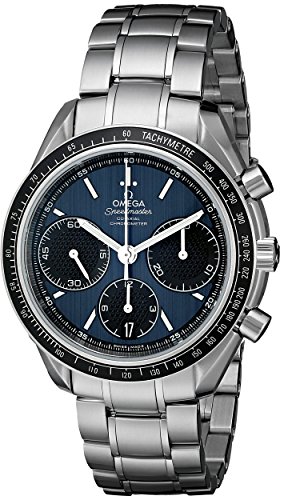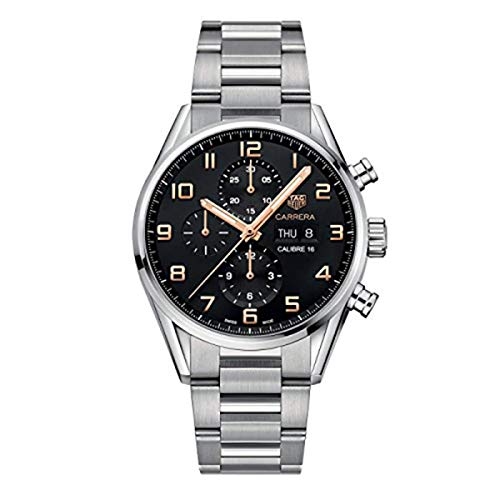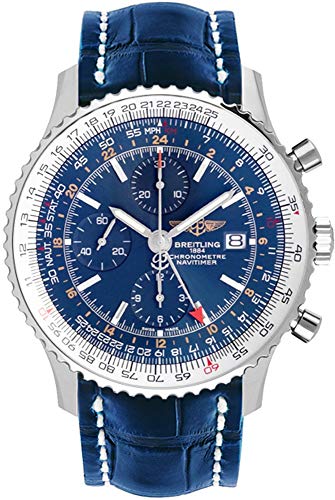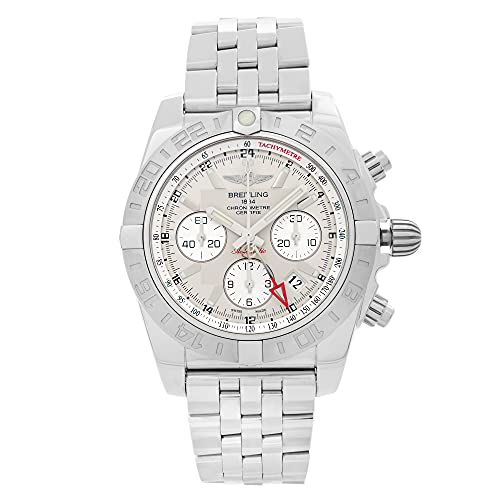Are you a racing enthusiast who relies on a chronograph to measure speed and time? Have you ever wondered if the tachymeter on your racing chronograph can be calibrated or adjusted? If so, you’re not alone. In this blog post, we’ll explore this burning question and dive deep into the fascinating world of racing chronographs. Join us as we unravel the mysteries behind these timekeeping devices and uncover the truth about their tachymeters. Get ready to embark on an exciting journey that will leave you with a newfound understanding of the precision and accuracy required in the world of racing.
Top Picks for Precision Timing with Racing Chronographs



Understanding Racing Chronographs
Racing chronographs are indispensable tools in the world of motorsports. These timekeeping devices are specifically designed to measure and record the speed and performance of vehicles on the racetrack. In this blog, we will delve deeper into understanding racing chronographs, exploring their features, and examining their importance in motorsports.



What are Racing Chronographs?
Racing chronographs are wristwatches equipped with additional timing functionalities specifically tailored for motorsports. These watches integrate various features that enable drivers and race enthusiasts to measure and compute crucial lap times, average speeds, and other performance metrics. Besides assisting in track timing, racing chronographs also serve as stylish accessories that reflect one’s passion for motorsports.
Features of Racing Chronographs
- Chronograph Functions: Racing chronographs incorporate chronograph complications, allowing users to time laps accurately. This includes features such as start, stop, and reset functions, along with counters to display elapsed time.
- Tachymeter Scale: A tachymeter scale is a common feature found on racing chronographs. It enables users to measure speed based on a known distance. By simply starting the chronograph when passing a fixed point and stopping it at the next, the tachymeter scale can be used to determine average speed.
- Luminosity: Racing chronographs often prioritize good visibility. They feature luminous hands and markers, making it easier for drivers to read time and performance metrics, even in low-light environments.
- Water Resistance: Many racing chronographs have water-resistant properties, making them capable of withstanding exposure to moisture and potential splashes on the track. This durability ensures their functionality is not compromised during intense racing conditions.
- Durable Materials: Racing chronographs are typically constructed from robust materials such as stainless steel or titanium, ensuring they can withstand rough handling and the demands of racing.
Importance of Racing Chronographs in Motorsports
- Performance Evaluation: Racing chronographs allow drivers to evaluate their performance and make necessary adjustments. By tracking lap times and comparing them, drivers can identify areas for improvement and work towards reducing overall lap time.
- Strategy and Tactics: Racing chronographs aid in developing effective race strategies. By analyzing lap times, drivers can determine the optimal moments to pit, overtake opponents, and exploit potential opportunities on the track.
- Record Keeping: Chronographs enable drivers to maintain a record of their performance over time, which is particularly important for professional racers. These records provide valuable insights that assist in honing driving skills and help to track progress throughout a season.
- Enhanced Safety: Timing and performance measurements captured by racing chronographs are utilized in safety evaluations by race organizers. These devices help ensure adherence to speed limits and track regulations, promoting a safer racing environment.
What is a Tachymeter?
When it comes to racing chronographs, a key feature that sets them apart from regular timepieces is the tachymeter. A tachymeter is a built-in scale on the bezel or dial of a watch that allows for the measurement of speed or distance based on time. It’s an essential tool for racing enthusiasts, allowing them to accurately track their speed during various activities, such as driving, cycling, or running.



Construction and Functioning of Tachymeters
Tachymeters are typically found on the bezel or outer rim of the watch dial. Although their precise design may vary, they generally consist of a scale that displays units per hour (km/h or mph). The scale is divided into smaller increments, making it easier to calculate speed or distance.
To use a tachymeter, you need to start a timer and determine the time it takes to cover a known distance. Once the desired distance has been covered, stop the timer and the second hand will indicate a specific point on the tachymeter scale. Here, you can read the corresponding speed or distance value.
The functioning of tachymeters is based on the inverse relationship between speed, time, and distance. By measuring the time it takes to travel a known distance, you can calculate your average speed or determine the distance covered at a specific speed.
Key Benefits and Applications of Tachymeters
Tachymeters offer several advantages for those who rely on precise speed or distance measurements. Some of the key benefits and applications of tachymeters include:
- Versatility: Tachymeters can be used in various activities that require speed or distance calculations, including sports, racing, and outdoor adventures.
- Accuracy: Tachymeters provide accurate readings, making them valuable tools for anyone seeking precise measurements of speed or distance.
- Convenience: Having a tachymeter built into your watch eliminates the need for separate measurement tools, making it a practical and convenient solution.
- Racing Chronographs: Tachymeters are commonly found in racing chronographs. These watches are specifically designed for motorsport enthusiasts and are equipped with additional features such as chronograph functions, multiple sub-dials, and robust construction.
How to Use a Tachymeter
To use a tachymeter effectively, follow these steps:
- Start the chronograph function on your watch when you pass a known starting point.
- Stop the chronograph once you reach the desired distance, such as a mile or kilometer.
- Read the position of the chronograph’s second hand on the tachymeter scale.
- The value indicated corresponds to your average speed in units per hour (km/h or mph).
Calibrating a Tachymeter
A tachymeter is a valuable tool found on racing chronographs, designed to measure average speed over a known distance. It is widely used by motorsport enthusiasts and professionals to calculate speeds for cars, motorcycles, and even runners. However, like any timekeeping device, the accuracy of a tachymeter may be affected over time. In this blog section, we will explore the possibility of calibrating a tachymeter on your racing chronograph to ensure its accuracy.



Factors affecting tachymeter accuracy
Before delving into the calibration process, it’s important to understand the factors that can impact the accuracy of a tachymeter. These factors include:
- Manufacturing tolerances: Like any mechanical or electronic device, tachymeters are subject to manufacturing tolerances. These tolerances can cause slight variations in the accuracy of the scale.
- Wear and tear: Over time, the components of a tachymeter can experience wear and tear, leading to decreased accuracy. This is particularly true for mechanical tachymeters, which rely on moving parts.
- Environmental conditions: Extreme temperatures, exposure to moisture, and other environmental factors can affect the performance of a tachymeter. This can result in deviations from the original accuracy.
Methods for tachymeter calibration
While tachymeters are typically calibrated during the manufacturing process, there are methods you can employ to recalibrate or adjust the accuracy of your tachymeter. These methods include:
Professional calibration
Professional watchmakers or service centers employed by the watch brand can provide a high level of precision in calibrating tachymeters. This involves disassembling the chronograph, adjusting the tachymeter scale, and conducting tests to ensure accurate readings.
Benefits of professional calibration:
- Expertise in handling delicate watch mechanisms.
- High level of precision in calibration.
- Thorough testing to verify accuracy.
DIY calibration
For those who prefer a more hands-on approach, there are DIY methods available for calibrating a tachymeter. While not as precise as professional calibration, these methods can still yield satisfactory results. Some steps for DIY calibration include:
- Comparison with a known distance: Choose a fixed distance, for instance, a kilometer marker on a race track, and use a stopwatch to measure the time it takes for a vehicle or object to cover that distance. Compare the calculated speed with the reading on the tachymeter and make any necessary adjustments.
- Reference speed measurement devices: Use GPS-enabled devices or radar guns to measure the speed of a moving object accurately. Compare the measured speed with the tachymeter reading and adjust accordingly.
Benefits of DIY calibration:
- Cost-effective option.
- Can be done at home with basic tools.
- Allows for customization to individual preferences.
Limitations and considerations
When attempting to calibrate a tachymeter, it’s important to consider the following limitations:
- Mechanical limitations: Mechanical tachymeters, particularly those found in vintage timepieces, may have physical limitations that restrict the possibility of calibration.
- Reliability of reference devices: The accuracy of the calibration process heavily relies on the accuracy of the reference devices used. Ensure these devices are calibrated regularly and are of high quality.
Factors to Consider
When it comes to tachymeters, ensuring accuracy and maintaining optimal functionality is crucial. However, there may come a time when you need to decide whether a calibration or adjustment is necessary. In this blog section, we discuss the key factors to consider when making this decision. Let’s delve into the essential aspects that can influence your choice:



1. Accuracy is Paramount
- Having accurate readings is fundamental when using a tachymeter. Accurate measurements are essential for various activities, such as calculating speed, distance, and other parameters.
- Calibrating or adjusting your tachymeter ensures that the readings are precise and reliable, providing you with the confidence to make precise calculations.
2. Expertise Required
- Calibrating or adjusting a tachymeter is a highly technical task that requires specific knowledge and skills.
- Unless you possess the necessary expertise, it is strongly recommended to seek professional assistance. A trained technician who specializes in tachymeter calibration will ensure accurate adjustments and prevent any potential damage to your instrument.
3. Impact on Functionality
- Before making a decision, consider the potential impact on the chronograph’s functionality.
- Calibrating a tachymeter can improve its accuracy, ensuring it remains aligned with industry standards.
- Adjusting a tachymeter may be required if you notice any issues with its performance, such as inconsistent readings or irregular behavior.
Table: Calibration vs. Adjustment – Key Points
| Calibration | Adjustment |
|---|---|
| Ensures accuracy | Address performance issues |
| Precise and reliable readings | Aligns with industry standards |
| Professional expertise required | Expertise advised but not necessary |
Finding the answer
In summary, if you are a racing enthusiast and rely on your chronograph’s tachymeter for accurate measurements, it is essential to get it calibrated by a professional. Rather than attempting to adjust it yourself, seek expert advice to maintain precision and keep your chronograph performing at its best.
Frequently Asked Questions about Racing Chronographs with Tachymeters
Can the wear and tear of regular usage impact the accuracy of the tachymeter on a racing chronograph, and if so, how can it be mitigated or addressed?
Yes, the wear and tear of regular usage can impact the accuracy of the tachymeter on a racing chronograph. The tachymeter is a feature on chronograph watches used to measure speed based on time elapsed. Over time, the moving parts and multiple mechanisms involved in the tachymeter can experience minor shifts or calibration issues, resulting in reduced accuracy.
To mitigate or address this issue, regular maintenance and servicing of the chronograph is essential. It is recommended to have the watch serviced by a certified watchmaker or authorized service center at regular intervals, typically every 2-5 years depending on the watch manufacturer’s guidelines. During the service, the watch will be examined, cleaned, and necessary adjustments will be made to restore accuracy.
Additionally, caring for the watch properly can also help minimize the impact of wear and tear. This includes avoiding extreme temperature changes, moisture, and impact or shock to the watch. Storing the watch in a proper watch box when not in use and handling it with care can also contribute to its longevity and accuracy.
Regular usage and exposure to external factors can affect the tachymeter’s accuracy, but with routine maintenance and proper care, the impact can be mitigated, ensuring the chronograph functions accurately over an extended period.
How frequently should the tachymeter on a racing chronograph be calibrated or adjusted for optimal precision?
The tachymeter on a racing chronograph does not need to be calibrated or adjusted for optimal precision on a frequent basis. It is designed to remain accurate for an extended period of time and does not typically require regular calibration. However, if the chronograph’s performance is noticeably deviating from accurate readings, it is advisable to have it professionally calibrated by an authorized service center. In general, occasional calibration or adjustment may be necessary if the tachymeter starts to show significant inaccuracies, but it largely depends on the specific model and manufacturer’s recommendations.
What are the potential consequences or inaccuracies that can arise from a misaligned or poorly calibrated tachymeter on a racing chronograph?
A misaligned or poorly calibrated tachymeter on a racing chronograph can lead to various potential consequences or inaccuracies.
- Incorrect speed calculations: The primary purpose of a tachymeter is to measure speed based on time and distance. If the tachymeter is misaligned or not calibrated accurately, it can provide incorrect speed readings. This can be problematic for racing enthusiasts who rely on accurate information for performance analysis and decision-making.
- Inaccurate lap times: Racing chronographs often feature a tachymeter that assists in measuring lap times. If the tachymeter is not properly calibrated, it can lead to inaccurate lap time measurements. This can affect race analysis, performance comparisons, and records.
- Miscalculations in other measurements: Tachymeters can also be used to measure other factors like distance or fuel consumption. Misalignment or poor calibration can result in inaccurate measurements, leading to incorrect data analysis and potential errors in race strategies or performance evaluation.
- Loss of confidence and trust: A misaligned or poorly calibrated tachymeter can erode the trust and confidence users have in the accuracy and reliability of the chronograph. This can damage the manufacturer’s reputation and lead to dissatisfaction among users.
- Inconsistent readings: A misaligned or poorly calibrated tachymeter may result in inconsistent readings, which can be frustrating for users. Consistency is crucial in racing chronographs to ensure reliable data for accurate performance analysis.
